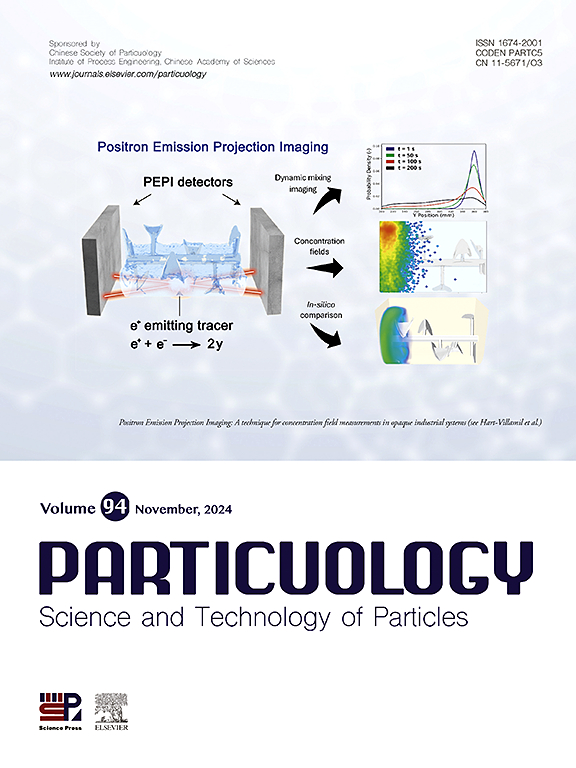流化床内喷射的x射线计算机断层扫描(XCT)研究:双组分流化效应
IF 4.1
2区 材料科学
Q2 ENGINEERING, CHEMICAL
引用次数: 0
摘要
非球形颗粒的流态化在生物质和固体废物处理工业中很常见,而曝气板上方的喷射特性对这些颗粒的流态化性能至关重要。本研究采用柱状颗粒作为典型的非球形颗粒,与小床物料颗粒共流化。x射线计算机断层扫描(XCT)用于重建曝气板区域的三维结构,允许识别单个曝气射流。研究了射流速度(Uj)、柱状颗粒质量分数(ω)、柱状颗粒密度(ρi)和柱状颗粒球度(φ)对射流形状和体积的影响。实验结果表明,减小柱状颗粒质量分数(ω)和颗粒密度(ρi)可以增大射流长度(L)、最大射流直径(D)和最大射流体积(V),但对射流半角(θ)影响不大。柱状颗粒密度(ρi)是影响射流形状的最敏感因素,而柱状颗粒球度(φ)对射流形状的影响不显著。在综合实验结果的基础上,提出了双组份流化床射流长度(L)与柱状颗粒和床物料之间的关系。本文章由计算机程序翻译,如有差异,请以英文原文为准。
X-ray computed tomography (XCT) study of jetting in a fluidized bed: Effects of two-component fluidization
Fluidization of non-spherical particles is commonly found in the biomass and solid waste processing industry, and the jetting characteristic above the aeration plate is critical to the fluidization performance of these particles. In this study, cylindrical particles are used as typical non-spherical particles and co-fluidized with small bed material particles. X-ray computed tomography (XCT) is used to reconstruct the 3D structure of the aeration plate region, allowing for the identification of individual aeration jets. The effects of jet velocity (Uj), cylindrical particle mass fraction (ω), cylindrical particle density (ρi), and the cylindrical particle sphericity (ϕ) on jet shape and volume are investigated. The experimental results indicate that decreasing the cylindrical particle mass fraction (ω) and particle density (ρi) increases the jet length (L), maximum jet diameter (D), and maximum jet volume (V), but have little effect on the jet half angle (θ). The cylindrical particle density (ρi) is the most sensitive factor for jet shape, while the effect of cylinder particle sphericity (ϕ) on jet shape is insignificant. A correlation of jet length (L) in a two-component fluidized bed with cylindrical particles and bed material is proposed based on all the experimental results.
求助全文
通过发布文献求助,成功后即可免费获取论文全文。
去求助
来源期刊

Particuology
工程技术-材料科学:综合
CiteScore
6.70
自引率
2.90%
发文量
1730
审稿时长
32 days
期刊介绍:
The word ‘particuology’ was coined to parallel the discipline for the science and technology of particles.
Particuology is an interdisciplinary journal that publishes frontier research articles and critical reviews on the discovery, formulation and engineering of particulate materials, processes and systems. It especially welcomes contributions utilising advanced theoretical, modelling and measurement methods to enable the discovery and creation of new particulate materials, and the manufacturing of functional particulate-based products, such as sensors.
Papers are handled by Thematic Editors who oversee contributions from specific subject fields. These fields are classified into: Particle Synthesis and Modification; Particle Characterization and Measurement; Granular Systems and Bulk Solids Technology; Fluidization and Particle-Fluid Systems; Aerosols; and Applications of Particle Technology.
Key topics concerning the creation and processing of particulates include:
-Modelling and simulation of particle formation, collective behaviour of particles and systems for particle production over a broad spectrum of length scales
-Mining of experimental data for particle synthesis and surface properties to facilitate the creation of new materials and processes
-Particle design and preparation including controlled response and sensing functionalities in formation, delivery systems and biological systems, etc.
-Experimental and computational methods for visualization and analysis of particulate system.
These topics are broadly relevant to the production of materials, pharmaceuticals and food, and to the conversion of energy resources to fuels and protection of the environment.
 求助内容:
求助内容: 应助结果提醒方式:
应助结果提醒方式:


